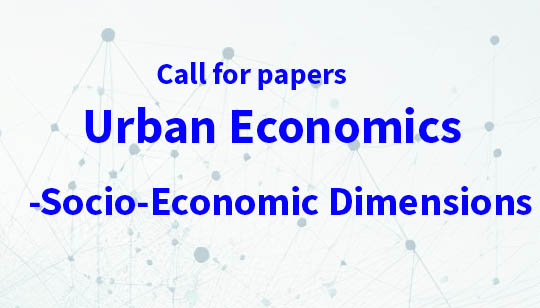Mathematical Model Applied to Green Building Concept for Sustainable Cities Under Climate Change
DOI:
https://doi.org/10.25034/ijcua.2022.v6n1-4Keywords:
Green Building, Sustainable Cities, Climate Change, Mathematical Model, Numerical SimulationsAbstract
Recently the effect of greenhouse gases (GHGs) is worldwide terrified anxiety to the public and scholars. Even this global problem is one of the great issues that continuously makes worrying the governments and environmentalists, but its solution findings are not out of the image at all. In this study, we have proposed and analysed a mathematical model for the solvable management of GHGs by sowing the seeds of green building dynamic systems. Moreover, in the model, the human community is used to enhance the production power of individuals of green buildings by absorbing the GHGs. The model is analysed by stability analysis at the equilibrium points: trivial and global equilibrium, and also by convincing the stability and instability of the system of equations. The behaviour of the propound model has been developed by numerical simulations which shows the rate of the fruitfulness of GHG components.
Downloads
References
Biswas, M. H. A., Hossain, M. R., & Mondal, M. K. (2017). Mathematical modelling applied to sustainable management of marine resources. Procedia Engineering, 194, 337-334.
https://doi.org/10.1016/j.proeng.2017.08.154
Biswas, H. A., Rahman, T., & Haque, N. (2016). Modeling the potential impacts of global climate change in Bangladesh: an optimal control approach. Journal of Fundamental and Applied Sciences, 8(1), 1-19. https://doi.org/10.4314/jfas.v8i1.1
Broom, D., & Gray, A. (2020). The US is set to rejoin the Paris climate agreement. Here’s what you need to know. Regional Agenda: Environment and Natural Resource Security, Climate Change, GreenHorizon2020. World Economic Forum. Retrieved from:. https://www.weforum.org/agenda/2020/11/paris-agreement-climate-change-us-biden/
Edenhofer, O. R., Pichs-Madruga, R., Sokona, Y., Farahani, E., Kadner, S., Seyboth, K., Adler, A., Baum, I., Brunner, S., Eickemeier, P., Kriemann, B., Savolainen, J., Schlomer, S., Stechow, Z. V., Zwickel, T., & Minx, J. C. (2014). Climate Change 2014: Mitigation of Climate Change. Working Group III Contribution to the Fifth Assessment Report of the Intergovernmental Panel on Climate Change. Cambridge University Press, Cambridge, United Kingdom and New York, USA. https://www.ipcc.ch/site/assets/uploads/2018/02/ipcc_wg3_ar5_full.pdf
Gong, Y., & Song, D. (2015). Life Cycle Building Carbon Emissions Assessment and Driving Factors Decomposition Analysis Based on LMDI—A Case Study of Wuhan City in China. Sustainability, 7(12). https://doi.org/10.3390/su71215838
Grant, M., Pitt, H., & Larsen, K. (2021). Preliminary 2020 Greenhouse Gas Emissions Estimates for China. Rhodium Group, New York.
Gul, M. S., & Patidar, S. (2015). Understanding the energy consumption and occupancy of a multi-purpose academic building. Energy and Buildings, 87, 155-165. https://doi.org/10.1016/j.enbuild.2014.11.027
Hanley, M. (2015). Which countries emit the most greenhouse gas? Global Agenda: Environment and Natural Resource Security, Global Governance, World Economic Forum. https://www.weforum.org/agenda/2015/07/countries-emitting-most-greenhouse-gas/
Hausfather, Z. (2020). 2020 is on course to be the warmest year on record. Global Agenda: Environment and Natural Resource Security, Decarbonizing Energy, World Economic Forum.
Hethcote, H. W., & van den Driessche, P. (1995). An SIS epidemic model with variable population size and a delay. Journal of Mathematical Biology, 34, 177-194. https://doi.org/10.1007/BF00178772
Islam, A., & Biswas, M. H. A. (2020). Modeling the Effect of Global Warming on the Sustainable Groundwater Management: A Case Study in Bangladesh WSEAS TRANSACTIONS on MATHEMATICS, 19, 639-646. https://doi.org/10.37394/23206.2020.19.71
Jaffal, I., Ouldboukhitine, S.-E., & Belarbi, R. (2012). A comprehensive study of the impact of green roofs on building energy performance. Renewable Energy, 43, 157-164. https://doi.org/10.1016/j.renene.2011.12.004
Kara, B. (2019). The impact of globalization on cities. Journal of Contemporary Urban Affairs, 3(2), 108-113. https://doi.org/10.25034/ijcua.2018.4707
Kaygusuz, K. (2007). Energy for Sustainable Development: Key Issues and Challenges. Energy Sources, Part B: Economics, Planning, and Policy, 2(1), 73-83. https://doi.org/10.1080/15567240500402560
Larsen, K., Pitt, H., Grant, M., & Houser, T. (2021). China’s Greenhouse Gas Emissions Exceeded the Developed World for the First Time in 2019. Rhodium Group, New York. https://rhg.com/research/chinas-emissions-surpass-developed-countries/
Lebling, K., Friedrich, J., & Waite, R. (2020). Climate action must progress far faster to achieve 1.5°C goal. Global Agenda: Environment and Natural Resource Security, Green New Deals, World Economic Forum. https://www.weforum.org/agenda/2020/11/climate-action-emissions-target-paris-agreement
Liu, H., & Lin, B. (2016). Ecological indicators for green building construction. Ecological Indicators, 67, 68-77. https://doi.org/10.1016/j.ecolind.2016.02.024
Mandal, S., Islam, M. S., & Biswas, M. H. A. (2020). Modeling the Impact of Carbon Dioxide on Marine Plankton. INTERNATIONAL JOURNAL OF MATHEMATICS AND COMPUTERS IN SIMULATION, 14, 197-202. https://doi.org/10.46300/9102.2020.14.25
Mandal, S., Islam, M. S., & Biswas, M. H. A. (2021). Modeling the potential impact of climate change on living beings near coastal areas. Modeling Earth Systems and Environment, 7(3), 1783-1796. https://doi.org/10.1007/s40808-020-00897-5
Marchetti, C., Meyer, P. S., & Ausubel, J. H. (1996). Human population dynamics revisited with the logistic model: How much can be modeled and predicted? Technological Forecasting and Social Change, 52(1), 1-30. https://doi.org/10.1016/0040-1625(96)00001-7
Mardiana, A., & Riffat, S. B. (2013). Review on physical and performance parameters of heat recovery systems for building applications. Renewable and Sustainable Energy Reviews, 28, 174-190. https://doi.org/10.1016/j.rser.2013.07.016
Metz, B., Davidson, O., Bosch, P., Dave, R., & Meyer, L. (2007). Climate Change 2007: Mitigation of Climate Change. Cambridge University Press, Cambridge, United Kingdom and New York, NY, USA. https://www.ipcc.ch/site/assets/uploads/2018/03/ar4_wg3_full_report-1.pdf
Mondal, M. K., Hanif, M., & Biswas, M. H. A. (2017). A mathematical analysis for controlling the spread of Nipah virus infection. International Journal of Modelling and Simulation, 37(3), 185-197. https://doi.org/10.1080/02286203.2017.1320820
Nyári, J. (2011). Carbon footprint of construction products: a comparison of application of individual Environmental Product Declarations and Building Information Modeling software. https://www.theseus.fi/handle/10024/93737
Pacala, S., & Socolow, R. (2004). Stabilization Wedges: Solving the Climate Problem for the Next 50 Years with Current Technologies. Science, 305(5686), 968-972. https://doi.org/10.1126/science.1100103
Pal, S. K. D. (2017). Feasibility of a Carbon Consumption Tax for sustainable development–A case study of India. Journal of Contemporary Urban Affairs, 1(3), 18-23. https://doi.org/10.25034/ijcua.2018.3674
Parvin, T., Islam, A., Mondal, P. K., & Biswas, M. H. A. (2020). Discrete Type SIR Epidemic Model with Nonlinear Incidence Rate in Presence of Immunity. WSEAS TRANSACTIONS on BIOLOGY and BIOMEDICINE, 17, 104-118. https://doi.org/10.37394/23208.2020.17.13
Pollack, H. N., Hurter, S. J., & Johnson, J. R. (1993). Heat flow from the Earth's interior: analysis of the global data set. Reviews of Geophysics, 31(3), 267-280. https://doi.org/10.1029/93RG01249
Rahbarianyazd, R., & Raswol, L. (2018). Evaluating energy consumption in terms of climatic factors: A case study of Karakol residential apartments, Famagusta, North Cyprus. Journal of Contemporary Urban Affairs, 2(1), 45-54. https://doi.org/10.25034/ijcua.2018.3658
Reddy, S. (2016). The environmental benefits of building green-an overview. International Journal of Engineering and Management Research (IJEMR), 6(6), 109-113.
Reza, A. K., Islam, M. S., & Shimu, A. A. (2017). Green Industry in Bangladesh: An Overview. Environmental Management and Sustainable Development, 6(2), 124-143. https://doi.org/10.5296/emsd.v6i2.11027
Rezaie, B., Esmailzadeh, E., & Dincer, I. (2011). Renewable energy options for buildings: Case studies. Energy and Buildings, 43(1), 56-65. https://doi.org/10.1016/j.enbuild.2010.08.013
Röck, M., Saade, M. R. M., Balouktsi, M., Rasmussen, F. N., Birgisdottir, H., Frischknecht, R., Habert, G., Lützkendorf, T., & Passer, A. (2020). Embodied GHG emissions of buildings – The hidden challenge for effective climate change mitigation. Applied Energy, 258(114107), 1–12. https://doi.org/10.1016/j.apenergy.2019.114107
Roper, W. (2021). This chart shows how global temperatures have risen since 1950. Global Agenda: Climate indicators, How to save the planet, World Economic Forum. https://www.weforum.org/agenda/2021/01/climate-change-global-warming-carbon-dioxide-emissions-science/
Roston, E. (2021). 2020 Ties for Hottest Year in the Hottest Decade Ever. Climate Adaptation, Bloomberg Green.
Sasanpour, F. (2017). Livable city one step towards sustainable development. Journal of Contemporary Urban Affairs, 1(3), 13-17. https://doi.org/10.25034/ijcua.2018.3673
Shanta, S. S., & Biswas, M. H. A. (2020). The impact of media awareness in controlling the spread of infectious diseases in terms of SIR model. Mathematical Modelling of Engineering Problems, 7(3), 368-376. https://doi.org/10.18280/mmep.070306
Shawkat, L. W., Al-Din, S. S. M., & Kuzović, D. (2018). Opportunities for Practicing Sustainable Building Construction in Kurdistan Region, Iraq. Journal of Contemporary Urban Affairs, 2(1), 69-101. https://doi.org/10.25034/ijcua.2018.3665
Smeets, E. M. W., Faaij, A. P. C., Lewandowski, I. M., & Turkenburg, W. C. (2007). A bottom-up assessment and review of global bio-energy potentials to 2050. Progress in Energy and Combustion Science, 33(1), 56-106. https://doi.org/10.1016/j.pecs.2006.08.001
Sovacool, B. K., & Brown, M. A. (2010). Twelve metropolitan carbon footprints: A preliminary comparative global assessment. Energy Policy, 38(9), 4856-4869. https://doi.org/10.1016/j.enpol.2009.10.001
Tathagat, D., & Dod, R. D. (2015). Role of green buildings in sustainable construction-need, challenges and scope in the Indian scenario. IOSR Journal of Mechanical and Civil Engineering (IOSR-JMCE) 12(2), 01-09.
Wang, S., Fang, C., Guan, X., Pang, B., & Ma, H. (2014). Urbanisation, energy consumption, and carbon dioxide emissions in China: A panel data analysis of China’s provinces. Applied Energy, 136, 738-749. https://doi.org/10.1016/j.apenergy.2014.09.059
Wu, X., Peng, B., & Lin, B. (2017). A dynamic life cycle carbon emission assessment on green and non-green buildings in China. Energy and Buildings, 149, 272-281. https://doi.org/10.1016/j.enbuild.2017.05.041
Yau, Y. H., & Hasbi, S. (2013). A review of climate change impacts on commercial buildings and their technical services in the tropics. Renewable and Sustainable Energy Reviews, 18, 430-441. https://doi.org/10.1016/j.rser.2012.10.035
Yilmaz, D. G. (2021). Model Cities for Resilience: Climate-led Initiatives. Journal of Contemporary Urban Affairs, 5(1), 47-58. https://doi.org/10.25034/ijcua.2021.v5n1-4
Zhao, L., Oleson, K., Bou-Zeid, E., Krayenhoff, E. S., Bray, A., Zhu, Q., Zheng, Z., Chen, C., & Oppenheimer, M. (2021). Global multi-model projections of local urban climates. Nature Climate Change, 11, 152-157. https://doi.org/10.1038/s41558-020-00958-8
Zhu, C., & Yin, G. (2009). On competitive Lotka–Volterra model in random environments. Journal of Mathematical Analysis and Applications, 357(1), 154-170. https://doi.org/10.1016/j.jmaa.2009.03.066
Published
Issue
Section
License
Copyright (c) 2021 Professor Dr. Md. Haider Ali Biswas, M.Sc. Pinky Rani Dey, Asst. Prof. Md. Sirajul Islam, M.Sc. Sajib Mandal

This work is licensed under a Creative Commons Attribution 4.0 International License.






















